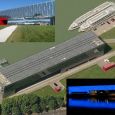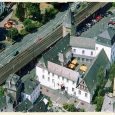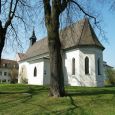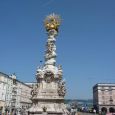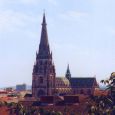Linz
Advertisement
By plane
The Blue Danube Airport of Linz is located outside the city, but there is a bus service to Linz from the airport, which takes about 20 minutes and costs around €3. A taxi costs around €25-30. Alternately, you can fly to the better-connected Vienna airport and take the train to Linz.
There are serveral connections with Lufthansa and Austrian Airlines from Munich, Frankfurt, Dusseldorf and Vienna to Linz.
By train
Linz has hourly Intercity and Eurocity connections to Salzburg and Vienna, and from there to all important European capitals and major cities. Austrian Federal Railways (ÖBB)[3] has online timetables and offers various ticketing options
By bus
ShuttleCeskyKrumlov.com (Shuttle bus from/to Cesky Krumlov). 1 hours. offers door-to-door shuttle bus and private car/van transportation to Vienna from Cesky Krumlov, Linz and back for 390 CZK (17 EUR) per person. See the timetable. €44.
By car
Linz is connected with Vienna, Salzburg, and Munich via the A1 Autobahn/motorway ; the Muehlviertel A7 Autobahn , and the south of Austria (Graz (Styria), Klagenfurt (Carinthia)) via the A9 Autobahn. It is also connected to Germany via Passau. There are plans to extend a motorway north to the Czech Republic, but work is not expected to start until 2009. The best way to drive north is currently on the B125 Bundesstrasse/B-road.
By boat
There is regular passenger boat service on the Danube from and to Vienna and Passau, Germany. A list of Austrian passenger services on the Danube can be found.
Advertisement
New cathedral
The building of the New Cathedral , also known as the Cathedral of the Immaculate Conception (Maria-Empfängnis-Dom) in Linz was begun in 1855 by Bishop Franz Joseph Rudigier. The first stone was laid in 1862, and in 1924 Bishop Johannes Maria Gföllner consecrated the finished building as the Cathedral of the Virgin Mary (Mariendom). The plans, drawn by the Master Builder of the Archdiocese of Cologne, Vincenz Statz, were made in the French high gothic style.
Old cathedral
Old cathedral, Domgasse 3. Daily 7AM-7PM.Designed according to drawings by Pietro Francesco Carlone, the cathedral was built between 1669 and 1678. It was the cathedral church of the diocese of Linz from 1785-1909. The single-nave Baroque church has lateral chapels and galleries, as well as a closed choir and stucco work by J.P. Spaz and G.B. Mazza. The marble high altar is by Colomba and Barberini with a picture by Antonio Bellucci. The Aloisian altar picture is by Bartolomeo Altomonte. The choir pews originate from the former monastery church in Garsten, while the organ by Franz Xaver Krismann derives from Engelzell monastery. From 1856-1868 Anton Bruckner served as the cathedral organist.
St. Martin's Church
This is regarded as the oldest original church still in existence in Austria. It was first documented in 799. A rectangular building that is no longer visible, partially extending into the nave, probably dates from the Agilofingian period (before 788). During the Carolingian period (after 788), the central structure was erected using debris from Roman buildings. This can be seen on both the inside and outside, while the ground plan is marked by stone slabs. The building was redesigned as a bay church in the 11th century and the pillar arches were filled in. There are Romanesque and Gothic door and window arches dating from later alterations. Inside the building, Roman stone inscriptions and a furnace can be seen. The first bay contains a copy of the Volto-Santo picture by Lucca (around 1440). The interior of the church can be viewed through a glass door. Entrance into the church is only permitted with a tourist guide.
Trinity Column
Trinity Column, in the middle of the Main Square. One of Austria's most attractive closed squares, there stands the 20 m high Baroque Trinity Column (completed in 1723). Carved in white marble by Sebastian Stumpfegger according to a model from Antono Beduzzi, the column bears three inscriptions. These announce the dedication of the column to the Holy Trinity by the guilds, the Emperor and the people of Linz in gratitude for deliverance from the dangers of war (1704), fire (1712) and plague (1713). The column is flanked by the patron saints Sebastian, Florian and Carlo Borromeo.
Linz castle
The Linz castle is first documented in 799. It was entirely rebuilt in 1477 by Emperor Friedrich III, and there are partial remains of the defensive walls, the bastions and the west entrance (Friedrichstor). The latter is adorned by a stone coat-of-arms (1481) bearing the inscription "AEIOU" ("The whole world is subject to Austria") and the imperial initials. Around 1600, during the rule of Rudolph II, the castle was redesigned and expanded according to plans by the Dutch master builder Anton Muys. The powerful four-story block with two inner courtyards and the main gate to the city (Rudolfstor 1604) date from this time. During the Napoleonic wars the building served as a military hospital, and it was here that the great city fire of 1800 broke out (destruction of the south wing and a part of the transept). Beginning in 1811, the remaining buildings were used as the provincial prison and from 1851 until 1945 as a barracks. Between 1953 and 1963, the fortress was rebuilt and restored as the Upper Austrian Castle Museum. It contains permanent exhibitions of art from the Middle Ages to the present day, historical weapons and musical instruments, coins, folklore and technical history, as well as the Kastner collection. There are special exhibitions each year.
Lentos Art Museum
As the successor of the New Gallery of the City of Linz, the Lentos Art Museum, which opened in May 2003, is among the most important museums of modern art in Austria. The clear and coherent structural design, created by the Zurich architects Weber & Hofer, provides Linz with a museum of art of international status, positioned in the urban context. The internationally acclaimed 130 meter long building by the Zurich architects Weber & Hofer provides approximately 8000 m2 for use and is located directly on the Danube between the Nibelungen Bridge and Brucknerhaus. The appearance of the building is remarkable for its transparent glass casing, attractively lit at night. There is a café with a viewing terrace on the ground floor.
Information not available
Information not available
Advertisement

